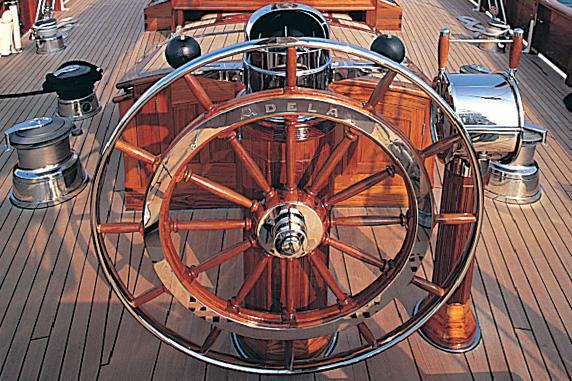
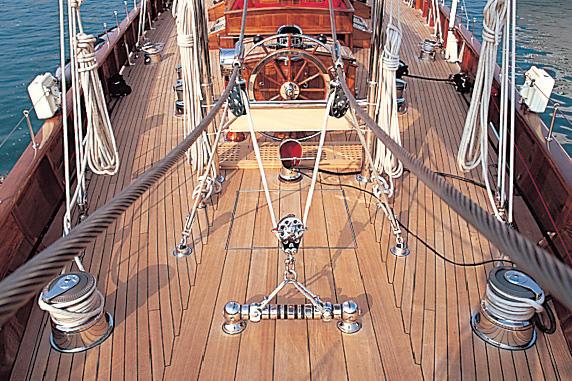
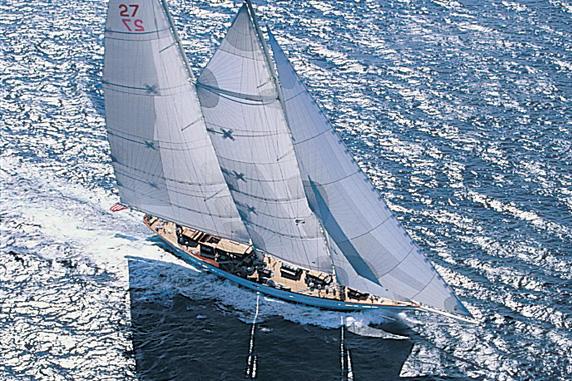
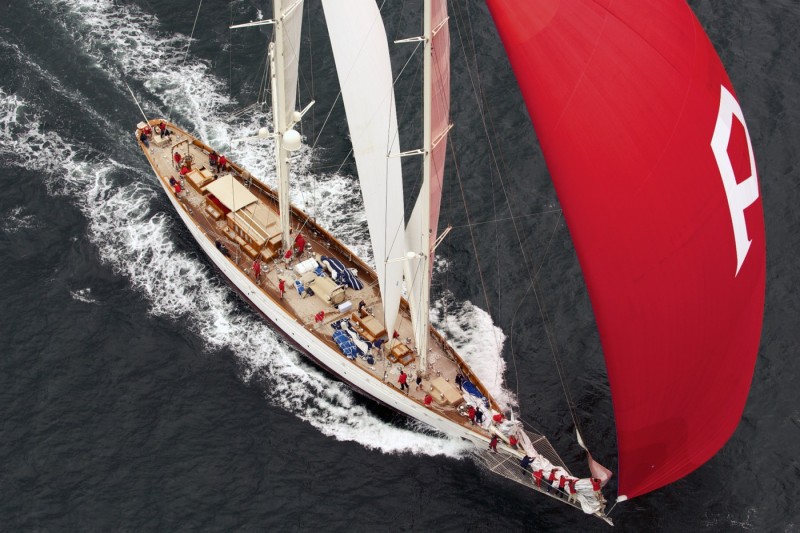
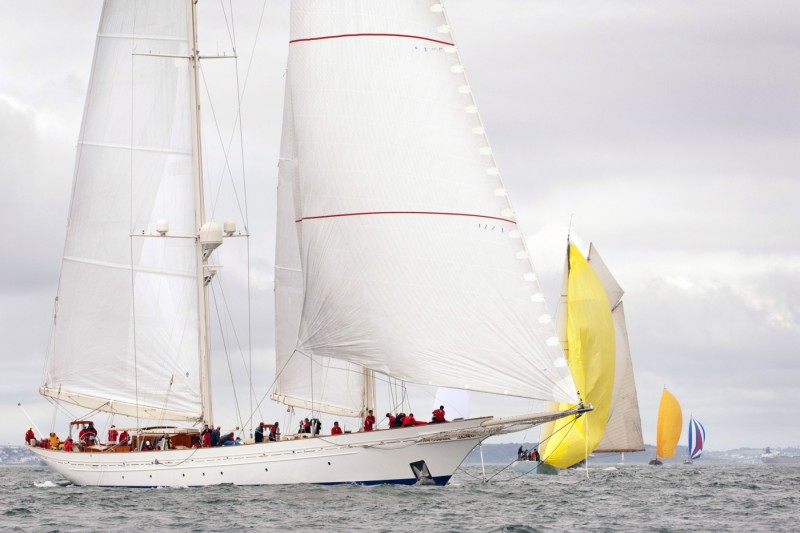
Previously named ‘Heartsease’ she had a remodelling in Pendennis Shipyard in 2000, which involved Dykstra Naval Architects, and they increased her overall length by cutting her in half and adding a section to her middle and adding a bowsprit.
Adela returned to Pendennis for subsequent refits in 2006, 2011 and 2012.
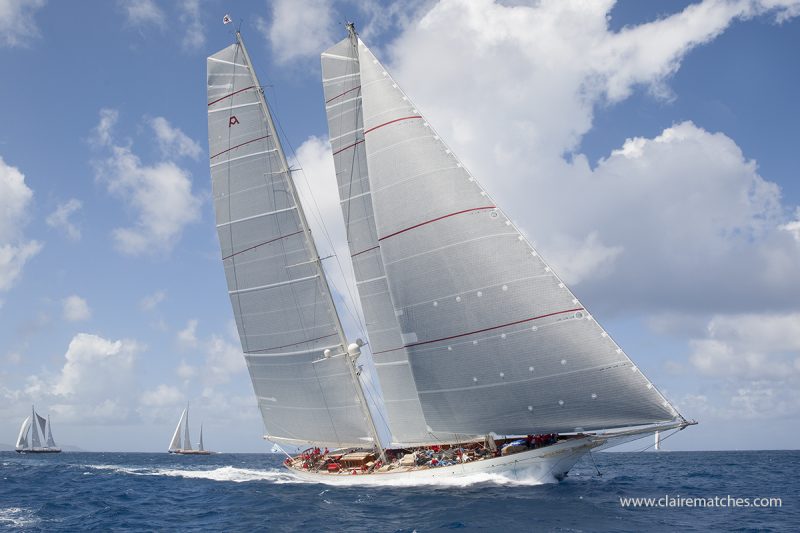
Patrick Archambeaud – Voiles Classiques
Originally a gaff rigged schooner, designed by William C. Storey, built in 1903 at J.G. Fay & Co in Southampton (GB) and renovated in 1995 at Pendennis in Falmouth under the direction of Gérard Dijkstra.
Originally a teak hull on steel, then completely rebuilt in steel during the 1992-1995 renovation.
The rigging is marconi, all carbon fibre spars, the mainmast is 46 metres above deck, spectra sails, quadrilateral genoa and 1100 m2 spinnaker, battened sail and wishbone on the foremast. The boat was refused in 1995 at the Nioulargue but accepted in Antigua in 1996 where it raced in the hands of Dennis Conner. The deck fittings are stainless steel and there are 35 Lewmar winches (17 of which are hydraulic).
Captain Greg Perkins. Crew of 35 to 40 people.
Launched as HEART SEAS for Claude Thorton Cayley of the Royal London Yacht Club, at the same time as a sister ship EVELYN. The owner received the trophy created by the Kaiser to reward the most beautiful schooner. First sold in 1914.
In 1924 she was bought by Henry Seimour King who named her HEARTSEASE.
An 87 hp engine was installed in 1933. Between 1937 and 1950 the boat no longer sailed, it remained in the mud at the Aldous shipyard in Brightlingsea.
She was used as a houseboat (for a certain Blott family) like so many others and in 1971 an attempt was made without success to renovate: a 30.5 ton steel keel replaced the 62 tons of lead ballast that had disappeared and a three-masted rig was fitted.
Commissioned by George Lindemann, the new American owner, the renovation began in 1992. The hull was towed from Lowestoft to Falmouth at Pendennis. The reconstruction was almost complete, the strong sheer and high freeboard recall the original plan and some original decorative elements were incorporated. The boat was launched on April 17, 1995 under the current name.
Sources: Jill Bobrow & Dana Jinkins in Yachts de tradition.
Excerpts from the site of G. Dijkstra. Various articles on the internet. Franco Pace in Voiliers de rêve.
Original Text from Voiles Classiques
Goélette aurique à l’origine, dessinée par William C. Storey, construite en 1903 chez J.G. Fay & Co à Southampton (GB) et rénovée en 1995 chez Pendennis à Falmouth sous la direction de Gérard Dijkstra.
Coque en teck sur acier à l’origine puis refaite tout acier lors de la rénovation de 1992-1995.
Le gréement est marconi, tous espars en fibre de carbone, le grand mât fait 46 mètres au-dessus du pont, voiles en spectra, génois quadrilatéral et spinnaker de 1100 m2, voile lattée et wishbone sur le mât avant. Le bateau a été refusé en 1995 à la Nioulargue mais accepté à Antigua en 1996 où il a couru aux mains de Dennis Conner. L’accastillage est en inox et on compte 35 winches Lewmar (dont 17 hydrauliques).
Capitaine Greg Perkins. Equipage de 35 à 40 personnes.
Lancée sous le nom de HEART SEAS pour Claude Thorton Cayley du Royal London Yacht Club, en même temps qu’un sister-ship EVELYN. Le propriétaire reçut le trophée créé par le Kaiser pour récompenser la plus belle goélette. Vendue pour la première fois en 1914.
En 1924 elle est achetée par Henry Seimour King qui l’appelle HEARTSEASE.
Un moteur de 87 ch est installé en 1933. Entre 1937 et 1950 le bateau ne navigue plus, il reste dans la vase au chantier Aldous à Brightlingsea.
Elle sert d’habitation (houseboat pour une certaine famille Blott) comme tant d’autres et en 1971 on tente sans succès un essai de rénovation : une quille en acier de 30,5 tonnes vient remplacer les 62 tonnes du lest en plomb disparu et on pose un gréement à trois mâts.
Commandée par George Lindemann, nouveau propriétaire américain, la rénovation commence en 1992. La coque est remorquée de Lowestoft à Falmouth chez Pendennis. La reconstruction est quasi-totale, la forte tonture et le haut franc-bord rappellent le plan d’origine et quelques éléments originaux de décoration ont été incorporés. Le bateau est lancé le 17 avril 1995 sous le nom actuel.
Polémique sur le gréement et les œuvres vives agrandies pour accueillir toute commodités et installations modernes (le bateau a été coupé en deux et agrandi de 15 ft). Ainsi ADELA n’est aujourd’hui ni une réplique ni une restauration … elle dérange fort logiquement les puristes et, superbe, elle court à 17 kt avec les Maxis Yachts de la Rolex Cup dans la catégorie Esprit de Tradition.
- Sources : Jill Bobrow & Dana Jinkins in Yachts de tradition.
Extraits du site de G. Dijkstra. Différents articles sur internet. Franco Pace in Voiliers de rêve.








